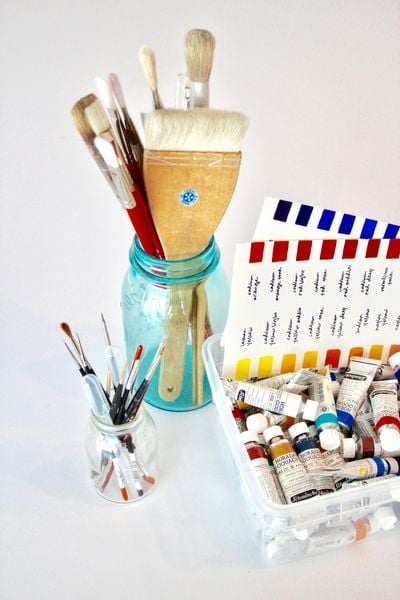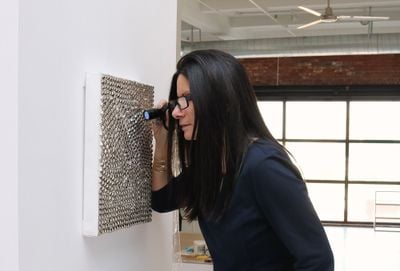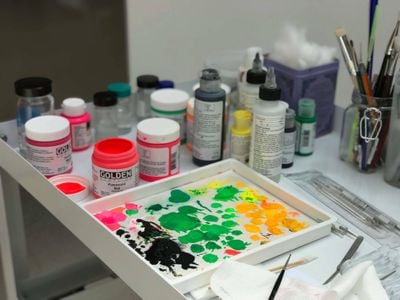
Art Conservator Suzanne Siano Makes the Visible Invisible
Imagine holding an unframed van Gogh, undisturbed. Tracing your gloved fingertips along licks of thick impasto, or scrutinising the smallest of variations in cobalt blue and chrome yellow that colour the corners of a canvas.
It's a privilege that is hard to imagine when pushing your way through crowds at the Metropolitan Museum of Art or Musée d'Orsay, who have presented hugely popular surveys of the artist in recent years.
This privilege was granted to Suzanne Siano, a former painting conservator at the Museum of Modern Art in New York, where van Gogh's magnum opus, The Starry Night (1889), is on display, framed and with protective glazing.
To understand more about the painting and its materials, MoMA's team of patient and fearless conservators—Siano included—took it for non-destructive analysis, removing it from its frame and examining it up close.
Trained at the Conservation Center of the Institute of Fine Arts, New York University, Siano spent 13 years working at MoMA, and in 2007 established Modern Art Conservation, a private conservation practice catering to collectors, auction houses, galleries, and museums in New York.
Specialising in modern and contemporary paintings, Siano and her team have become the first port of call for U.S. collectors when a smiley face is scribbled on a prized artwork, or for artists wanting advice on what materials will stand the test of time.
Ocula Director Eva Fuchs spoke with Siano about the artworks she has most enjoyed restoring, why paintings by Ad Reinhardt and Ellsworth Kelly are challenging, and works that have aroused her suspicion.
How did you get interested in art conservation?
I was always an art history person. It was the only thing I wanted to study. When I studied for my BA at Barnard College (part of Columbia University), I took a class taught in Italian Renaissance art.
At that time the Sistine Chapel was being restored, which my professor was adamantly against. His theories on how Renaissance artists were connected were predicated upon the fact that the ceiling was dark and appeared smoky. So despite strongly opposing its conservation, his introduction to the profession fascinated me. When I learned that conservation combines art history, science, and practical, hands-on art skills, I was determined to make it my profession.
How has conservation changed since you started?
When I started practising, very few American museum collections had dedicated conservation departments. Also, those buying at auction or from galleries would often take the seller's word on the condition of an artwork.
But something changed around 2010. Everyone thought the art market would plummet after the 2008 financial crisis, but it went up, and people realised that an artwork's condition mattered and conservators with a high level of specialisation and objectivity were needed.
When I set up my practice in 2007, there were only a few other modern and contemporary art conservators in New York. Suddenly, I found myself getting deliveries of seven Warhols in one day.
Is there a work you've enjoyed conserving the most?
That's a hard question! For me, it is most exciting when I get to work on an artwork by an artist whose work I love, or perhaps a work that I've known my whole life. It is incredibly soul-satisfying to have this caretaking role in the life of an artwork, and bring back to life something that has seen hard days through your skills and expertise.
One of my favourite artist's works to conserve is Andy Warhol. I grew up seeing Warhol in New York, and going to Studio 54 when I was probably way too young to be going there myself. I'd also see him at Bloomingdale's and my mum would point out, 'Look, there's Andy!' I felt he was part of my world and was always a great fan of his art.
When I started working with the Andy Warhol Foundation for the Visual Arts it was so exciting. While everything we do is super confidential and you can't share things publicly, I would call my mum to tell her of the latest Warhol painting I was working on—Flowers, an Elvis, or an Elizabeth Taylor portrait.
What is it like when you're alone with all those major works from art history, unframed and undisturbed?
It is an amazing feeling to have such an intimate life with art. One of my favourite experiences at MoMA was dusting the works in the empty galleries each week. Now, in my practice, we have what I call 'quiet access' to incredible private and corporate collections, auction houses before a sale, or museum and gallery exhibitions when no one is visiting.
I have been fortunate to treat incredible paintings including works by Jasper Johns, Joan Mitchell, Jackson Pollock, Claude Monet, and Pablo Picasso. At MoMA, I was entrusted with the treatment of many iconic works including René Magritte's The Lovers and Edward Hopper's House by the Railroad.
No matter how famous the artist is or how much time passes, I always feel connected to the paintings I've worked on. I recall walking into a museum in London and seeing one of the first Matisses I'd ever cleaned. I had no one to tell, so I found myself going up to the guard and exclaiming, 'That's my painting!'
You spend so much time with an artwork you end up feeling very connected to it. That access and intimacy is one of the best parts of the job.
Who is the most difficult blue-chip artist to restore?
Minimalist artworks—such as those by Ad Reinhardt, Yves Klein, or Ellsworth Kelly—are all quite difficult to work on due to their flat nature and matte surfaces. People are not so accepting of any kind of damage, crack, or discolouration in these types of paintings. It can be quite difficult to make damage to these surfaces invisible. You have to be very good at it. There's nowhere to hide.
A lot of what we do is explaining to the client or curator that sometimes we cannot make an artwork completely better, or a blemish fully invisible. Old Masters usually have a varnish that protects the painting from damage, but in many modern and contemporary artworks, the delicate paint is right at the surface.
With works by Warhol, we're lucky as our studio has a large archive of materials that was left behind after he died. Warhol saved everything—rolls of canvases painted in preparation for silkscreen, and test materials, as he worked out how to use materials like diamond dust. We can run tests on these to figure out exactly how to clean a particular painting, or which pigments we would need when painting a loss.
How do you strike a balance between the natural ageing of historic works, and the desire to preserve the image for contemporary viewers?
You need to know the artist's intent. Sometimes that could mean bringing in the artist, a curatorial expert, or perhaps someone from the artist's foundation to get their opinion on what is disrupting the artwork or taking away from the experience of that painting for viewers.
At some point, you have to accept age. You're not going to inpaint every crack on a painting unless there's a very good reason, but you might clean a work to regain colours that have become dull. With modern paintings—many of which haven't been varnished—it's often about removing yellow nicotine from the surface after being exposed to years of cigarette smoke, or dirt accumulated from hanging without the protection of glass or plexi.
Luckily for us, people who want to buy historically important paintings don't always expect them to be perfect. Even imperfections on an Ellsworth Kelly or Brice Marden can be acceptable if the work is important enough. But the intent of the artist has to remain strong enough in the artwork to outweigh any condition issues. The viewer should be able to see beyond the damages and the conservator can help navigate what conditions should be addressed to maintain what the artist intended.
What skills or qualities are important as a conservator?
One of our biggest superpowers is problem-solving. We have to figure out how the damage happened, what materials and techniques will best work for the task at hand, and how far to take a treatment without intervening too much.
Our goal is to be ethical and use reversible materials so the next generation of conservators can remove our work if desired. We also do a lot of research into condition history, provenance, and historical images to know as much about the life of the artwork as possible.
When doing treatment, you need to be super meticulous and have a lot of patience, be somewhat fearless as it can be scary at times, but also have a healthy dose of fear so as not to do anything reckless or irreversible.
You want to channel the artist, but you are not the artist. You're not even the artist's assistant—you're really the artwork's doctor. You need to have distance, yet be very close at the same time. And that's not something everybody can do.
We also need to be neutral and represent the artwork and its best interests. For condition reports, we do not represent the buyer or seller. We try to objectively and thoughtfully describe the work's condition, particularly in relation to other works by the same artist. For treatment, we want to do what is best for the work in terms of representing the artist and the longevity of the work.
You and I keep meeting at art fairs. Why is it important for you to attend them?
At first I would just go for the experience of being there. But little by little, people started asking me to conduct condition reports or fix artworks ahead of art fairs here in New York.
Dealers were realising the need for conservators to provide condition reports to make sales happen right there and then at the fairs. Or maybe the condition required some work, so I would assess on behalf of the client as they would want to negotiate any conservation costs into the purchase price.
We're also there for advice. You may want to buy a painting to put in your pool house in Miami. In this instance, our role would be to advise whether the environment would be suitable for the painting, what the maintenance might be, or what toll of having the doors open for a party could have on the artwork.
I also meet a lot of artists who want advice on how to make their works or what materials might last. I've worked with artists including Dan Colen, Glenn Ligon, and Will Cotton. It's great to connect with them and be part of what they can create and what happens to their work.
It's obviously not your role to authenticate, but have you ever come across works that struck you as seeming fake?
After the art fraud scandal at New York's M. Knoedler & Co.—which saw the gallery's director, Ann Freedman sell $80 million worth of forged Pollocks, de Koonings, Rothkos, et cetera—people have become more vigilant about provenance.
It's very hard to tell somebody that they don't have a Pollock, Warhol, or Basquiat. Often there are indicators that something could be off, but that doesn't mean it's not authentic. The artwork could just be heavily restored or an outlier, not fitting what would be expected from the artist.
But there have been one or two instances when I knew an artwork was 100 percent fake. In one case, I found a hidden canvas stamp from a company that was not in business until after the artist had died.
Finally, what is the first thing a collector needs to do when their child wipes their sticky hands on their Twombly?
Don't try to clean it yourself, as it will often make it worse. Instead, call the conservator, your art advisor, or insurance company. It's also a good idea to periodically take pictures of the artwork as you may not notice small changes if you're living with it every day.
We've seen baseballs thrown into paintings, and smiley faces drawn onto canvases. It's a good idea to educate the people who live with artworks, that they are around something of cultural and not just monetary value, and should be mindful of it. Owning an artwork comes with the responsibility of maintaining it for generations to come. —[O]
Main image: Photo: Modern Art Conservation.





![Suzanne Siano and Andy Warhol's White Disaster [White Car Crash 19 Times] (1963).](https://files.ocula.com/anzax/Content/Advisory%20Verticals/Perspectives/2024/Suzanne%20Siano/SS-at-Warhol-White-Disaster_400_0.jpg)










